FUNDY ISSUES #21
Spring 2002
Putting the Fun In FundyPossibilities and Pitfalls of Ecotourism
"Ideally, ecotourism should do little, if any, lasting damage to
the region's
environment or to the natural features of particular interest"
Escalating ecotourism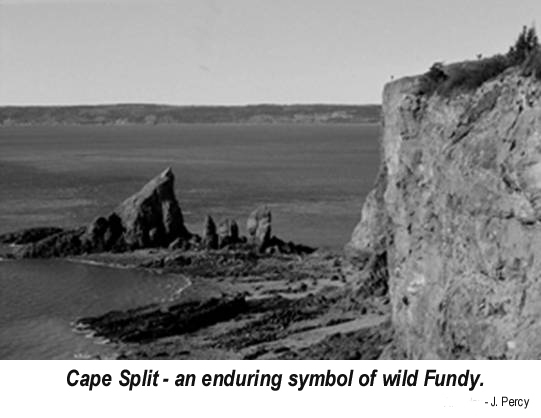
The proportion of the world's population that lives in cities and towns is
increasing rapidly. Every year, more and more of these urban residents try to get away
from the crowds and pressures of city living by seeking out relatively undisturbed natural
areas as a backdrop for their vacation activities. Some are looking for opportunities for
strenuous outdoor challenges such as mountain climbing, river rafting or sea kayaking.
Others simply want to experience and enjoy the tranquility of unspoiled nature for its own
sake. Throughout the world, such nature-based "adventure tourism" and
"ecotourism" are expanding more quickly than any other sector of the tourism
industry. This growth is largely driven by the interest of many affluent "baby
boomers" and their offspring in the environment and in conservation issues, and is
likely to continue for the foreseeable future. The United Nations General Assembly has
signaled how important ecotourism is to the global economy and the environment by
declaring 2002 to be the International Year of Ecotourism. Its press release announced
that the year "will be a time to review the ecotourism industry's effect on
biodiversity, its potential contribution to sustainable development, its social, economic
and environmental impacts, and the degree to which regulatory mechanisms and voluntary
programmes are effective in monitoring and controlling those impacts".
Canada, with its vast stretches of largely unspoiled wilderness and exceptional diversity of landscapes and wildlife, has long been a popular destination for tourists keen on the outdoors. Ecotourism now accounts for 10% of all tourism revenue, generates about $400 million annually and creates more than 10,000 jobs in Canada. Maritime destinations, particularly the Bay of Fundy region, are also sharing in this growing ecotourism boom. Such picturesque coastal areas are particular magnets for city dwellers. The Bay's legendary tides, working fishing villages and ruggedly scenic coastline have long drawn tourists to the area. Over the past decade, the New Brunswick Tourism Department has been aggressively marketing the many natural wonders of "New Brunswick's Bay of Fundy". In contrast, promotion of the Fundy shore of Nova Scotia has been rather low-key, although recent initiatives such as the Fundy Shore Ecotour in the upper Bay are a step in the right direction. Many communities and small businesses on both sides of the Bay are also expanding their efforts to attract more ecotourists by identifying and developing new opportunities in their region for outdoor recreation. And most of them are finding that the Bay of Fundy is rich in possibilities.
Fun in Fundy
The Fundy region offers a wide range of activities for those who want to
enjoy the great outdoors with a distinctive Maritime flavour. In the past decade there has
been a steady rise in the number of tourists interested in outdoor adventures and in
learning about the unique coastal geography and diverse wildlife of the region. The varied
coastal landscapes, ranging from waves-swept rocky shores and towering coastal cliffs to
seemingly endless ochre mudflats rimmed with lush saltmarshes, provide many diverse
habitats to explore and enough species of birds and other wildlife to keep naturalists
enthralled for weeks on end. Shorebirds, particularly the Semipalmated Sandpipers of the
upper Bay, and the seabirds and whales of the lower Bay are undoubtedly the star
attractions for naturalists and the general public alike. For those who simply enjoy
breathtaking coastal scenery Fundy also has much to offer. The rugged coasts flanking the
lower Bay are studded with rocky islands, picturesque fishing villages and craggy
headlands that delight painters and photographers. The vast sweeping mudflats rimming the
upper Bay miraculously appear and disappear to the endless rhythm of Fundy’s record
breaking tides and are a constant source of wonder to visitors. The high cliffs of Cape
Split and Cape D’Or, the sentinels flanking the entrance to the Minas Basin are
popular vantage points for observing the great swirling maelstroms of seawater that the
tide drives past them to fill the Basin twice daily.
Specially designated tourist routes allow ready access to coastal areas all around the
Bay of Fundy. In New Brunswick, the 450 kilometre long "Fundy Coastal Drive"
extends from St. Stephen on Maine's border to Aulac on the Nova Scotia frontier. The
provincial tourist guide promises that this route offers a "front-row seat to one of
the world’s most incredible natural phenomena". Then, across the border in Nova
Scotia, the Glooscap Trail, named after a legendary Mi’kmaq hunter, continues its
meandering way out along the Chignecto Peninsula to Advocate Harbour before looping
back around the Minas Basin to Truro and Windsor. At intervals, the distinctive
"Fundy Shore Ecotour" signs call attention to natural features of particular
interest in each of the region's six distinctive eco-zones. From Windsor, the Evangeline
Trail threads its leisurely way through the pastoral Annapolis Valley to Digby and then on
along the exposed "Acadian Shore" to Yarmouth. These linked "tourist
trails" provide ready access to diverse marine vistas all along the length of the
Nova Scotia coastline of the Bay of Fundy.
before looping
back around the Minas Basin to Truro and Windsor. At intervals, the distinctive
"Fundy Shore Ecotour" signs call attention to natural features of particular
interest in each of the region's six distinctive eco-zones. From Windsor, the Evangeline
Trail threads its leisurely way through the pastoral Annapolis Valley to Digby and then on
along the exposed "Acadian Shore" to Yarmouth. These linked "tourist
trails" provide ready access to diverse marine vistas all along the length of the
Nova Scotia coastline of the Bay of Fundy.
There are many opportunities for those who want to experience the Bay of Fundy even more closely and more viscerally. Coastal hiking trails of varying degrees of ruggedness abound, providing exercise and stunning vistas for casual strollers and seasoned hikers alike. Grand Manan, Fundy National Park, Cape Chignecto and Blomidon Provincial Parks, Cape Split and Brier Island are just a few of the locations that boast networks of coastal hiking or cycling trails that are second to none. Many communities around the Bay have also created their own coastal trails for the enjoyment of residents and visitors. Examples of such local initiative include the Delaps Cove Wilderness Trail near Annapolis Royal, the Thomas’ Cove Coastal Reserve near Economy, Nova Scotia and the Sackville Waterfowl Park in Sackville, New Brunswick.
It is now also possible to experience the Bay of Fundy even more closely! Sea kayaking has become an increasingly popular way to intimately explore less accessible coastlines and habitats around the Bay. A number of adventure tour companies on both sides of the Bay now cater to this growing demand. The awesome power of Fundy's tides and the treacherous nature of its currents and rips makes paddling with experienced local guides almost a necessity. Yet another way to experience the brute force of these surging waters is to ride a large, motorized rubber raft on the rolling crest of a tidal "bore". These racing mounds of roiling water, which can be up to three metres high, surge far inland along some of the rivers that empty into the upper Bay. This is one of the few places where you can experience the excitement of white water rafting while heading upriver! The tidal rafting mecca is undoubtedly the Shubenacadie River at the head of the Minas Basin, where several companies thrill thousands of adventure-seekers every season. Meanwhile, for those intrepid individuals who literally want to immerse themselves in Fundy, there are expanding opportunities to enjoy coastal scuba diving excursions led by knowledgeable local guides on both sides of the outer Bay.
Of course, Fundy can also be enjoyed at a much more leisurely, less frenetic pace. Its
beaches allow one to simply walk and enjoy the scenery or search the shoreline for its
varied treasures. In areas such as Cape Chignecto, 600-foot coastal cliffs create
breathtaking seascapes. Elsewhere, as at the Hopewell rocks, for example, the powerful
tides have sculpted the softer sea cliffs into unusual "flower pots", or sea
stacks, and excavated deep coastal caves. Beachcombers will find the strand strewn with a
wealth of unusual treasures, ranging from artistically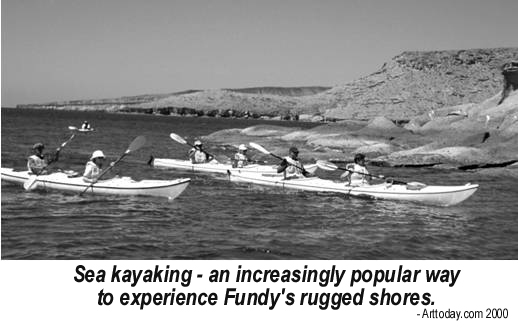 contorted
driftwood to colourful fishing floats as well as an intriguing trove of other wood, glass
and plastic flotsam originating from all around the North Atlantic.
contorted
driftwood to colourful fishing floats as well as an intriguing trove of other wood, glass
and plastic flotsam originating from all around the North Atlantic.
Visitors with a more geological bent, often nicknamed "rockhounds", find the beaches around the upper Bay a rich source of varied types of minerals. The lure of semiprecious stones such as agates, amethysts, and zeolites attract many collectors to the area. Ancient plant and animal fossils from many different geological epochs are also continually being eroded from the sedimentary cliffs and deposited on the beaches, particularly around Minas Basin and Chignecto Bay. Because of their geological uniqueness and great scientific value, many of these fossil beds are off limits to casual collectors. However, visitors can see samples and learn more about the rocks, gemstones, fossils and geological history of the region at places such as the Fundy Geological Museum in Parrsboro and the New Brunswick Museum in Saint John.
In many parts of the world, there is yet another form of ecotourism that is rapidly growing in popularity. So called "working ecotours" are described as "adventure travel with a conscience", and involve working alongside scientists as they carry out field studies in their particular disciplines. Participants are typically asked to pay a fee that covers their keep and also contributes towards funding the research. The volunteers help with the study and thus gain hands-on experience in a facet of science or natural history that interests them, under the guidance of a professional. The Earthwatch Institute, founded in 1981, links scientists around the world with people interested in volunteering for projects for one to three weeks. Volunteers can engage in archaeological digs, conservation projects, global change monitoring programs, wildlife studies, collecting trips and a wide range of ecological studies in diverse habitats. At present, in the Fundy region such opportunities are few, mostly small-scale and largely informal. They include helping with bird banding projects - mostly shorebirds in the upper Bay and migrating songbirds and other species on islands near the mouth of the Bay. Surge Inc., a whale watch and research organization based in St. Andrews, New Brunswick, offers paying volunteers an opportunity to assist a research scientist in his whale studies for periods ranging from a few hours up to 5 days. This is undoubtedly a type of ecotourism with some scope for further expansion in the Fundy region.
Balancing Benefits and Costs
Clearly, there can be many benefits from a thriving ecotourism industry in
an undeveloped region such as the Bay of Fundy. It creates jobs and stimulates economic
activity in areas that may be too remote for more traditional economic opportunities.
Therefore, it's not surprising that many communities all around the Bay have been scouring
their neighbourhoods for natural features and venues for outdoor activities that might
attract more visitors. Ideally, ecotourism should do little if any lasting damage to the
region’s environment or to the natural features of particular interest. If
well-managed, ecotourism can be sustainable and greatly benefit smaller communities
without any of the adverse environmental effects that often accompany industrial
development. Ecotourism is typically small-scale, involving individuals or small groups of
visitors with modest needs that can usually be met by small, community-based enterprises.
Ecotourists are often also interested in learning about the natural and cultural history
of the area, in addition to simply experiencing it. The growth of ecotourism worldwide is
a hopeful indicator of a rising interest in, appreciation for and concern about the
natural world. Public awareness of the value of coastal ecosystems is essential for their
continued protection and conservation.
However, there can also be too much of a good thing. At many popular tourist destinations, the sheer numbers of visitors are threatening the integrity of the habitats or the survival of the species that they have come to enjoy. There is a very fine and poorly defined balance between promoting a natural attraction and inadvertently destroying it. Around the Bay of Fundy, governments and other agencies and groups have devoted a lot of effort and resources to attracting as many tourists into the region as possible. However, too often, they act as if the "eco" in "ecotourism" is short for "economy" and not "ecology". Regrettably, they have tended to put much less effort into thinking about the possible adverse effects of this increased traffic upon the ecosystems and into devising ways of avoiding or reducing them. Promoters have to recognize that there may be limits beyond which some types of tourist activities are just no longer environmentally sustainable. It is not only the rising numbers of tourists that can interfere with delicate natural balances, but also the expanding network of roads, trails, accommodations and other facilities that they need. Often the expansion of this so-called "tourist infrastructure" occurs piecemeal, in small, seemingly harmless steps. Little thought is given to the accumulating environmental impacts until it is too late. The following are just a few examples of situations in the Fundy region where there may be an increasing potential for conflict between an expanding ecotourism industry and some of the natural features that sustain it.
Spooking Shorebirds?
Recently, a Canadian Wildlife Service scientist, long involved in studies
on the shorebirds around the upper Bay of Fundy, was rather disconcerted to find a large
advertisement in one of our national newspapers urging tourists to come to the Bay of
Fundy to see the great flocks of sandpipers. He has over the years seen first hand the
adverse effects that large numbers of visitors can have on these shorebirds. As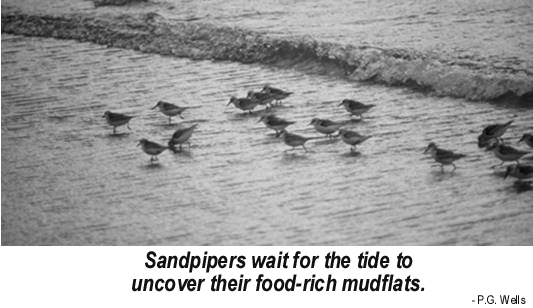 explained in
Fundy Issue # 3 "Shorebirds and Sediments", the relatively brief stopover
to feed on the Fundy mudflats is crucial to the successful migration of many species. The
great Fundy tides determine when they can feed on the exposed expanses of mud and when
they must rest and conserve their precious energy, huddled in large groups just above the
tide's reach. They are most accessible to tourists when they are thus concentrated on the
ground in these high shore roosts, but undeniably most spectacular and photogenic when
they are on the wing, wheeling and flowing in their uncannily orchestrated aerial ballet.
Unfortunately, on this point the best interests of the birds and the tourists are
diametrically opposed. There is little, if any, control over tourist access to the most
commonly used roosting areas and even the most enlightened visitor is tempted to approach
and spook the resting birds in order to experience their aerial magic. This seemingly
harmless practice, when carried out by a steady stream of visitors day after day, may be
devastating to these birds which must conserve and build up their energy reserves as
quickly as possible to enable them to fly nonstop to their wintering grounds in South
America. The Canadian Wildlife Service and representatives of the tourism industry are now
working together to find ways to allow the tourists to view the birds without disturbing
them. Some options include educating visitors, restricting them to well-defined trails or
walkways near the roosts and providing suitable "blinds" from which they can
view the birds. This approach appears to work well at Cap Tourmente, downriver from Quebec
City, where throngs of visitors can view immense flocks of migrating snow geese foraging
on the mudflats without bothering them.
explained in
Fundy Issue # 3 "Shorebirds and Sediments", the relatively brief stopover
to feed on the Fundy mudflats is crucial to the successful migration of many species. The
great Fundy tides determine when they can feed on the exposed expanses of mud and when
they must rest and conserve their precious energy, huddled in large groups just above the
tide's reach. They are most accessible to tourists when they are thus concentrated on the
ground in these high shore roosts, but undeniably most spectacular and photogenic when
they are on the wing, wheeling and flowing in their uncannily orchestrated aerial ballet.
Unfortunately, on this point the best interests of the birds and the tourists are
diametrically opposed. There is little, if any, control over tourist access to the most
commonly used roosting areas and even the most enlightened visitor is tempted to approach
and spook the resting birds in order to experience their aerial magic. This seemingly
harmless practice, when carried out by a steady stream of visitors day after day, may be
devastating to these birds which must conserve and build up their energy reserves as
quickly as possible to enable them to fly nonstop to their wintering grounds in South
America. The Canadian Wildlife Service and representatives of the tourism industry are now
working together to find ways to allow the tourists to view the birds without disturbing
them. Some options include educating visitors, restricting them to well-defined trails or
walkways near the roosts and providing suitable "blinds" from which they can
view the birds. This approach appears to work well at Cap Tourmente, downriver from Quebec
City, where throngs of visitors can view immense flocks of migrating snow geese foraging
on the mudflats without bothering them.
Worrying Whales?
In recent decades there has been a growing concern about the plight of many
of the great whales and a rising interest in seeing them in their natural habitat.
Worldwide, coastal whale watching has become a billion-dollar business, with more than
half of it taking place in North American waters. Each year an estimated 5.5 million
people embark on whale watching tours operating out of some two hundred communities
scattered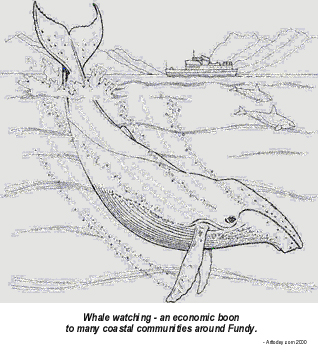 all along both coasts of Canada and the
United States. The Bay of Fundy has become a particular magnet for whale watchers because
it is the summering area for many endangered North Atlantic right whales as well as for
playful humpback whales that are real crowd-pleasers.
all along both coasts of Canada and the
United States. The Bay of Fundy has become a particular magnet for whale watchers because
it is the summering area for many endangered North Atlantic right whales as well as for
playful humpback whales that are real crowd-pleasers.
Several communities flanking the mouth of the Bay, particularly on Brier Island and Long Island in Nova Scotia and around Grand Manan Island and Passamaquoddy Bay in New Brunswick, are home to more than two dozen successful whale watching enterprises. Whale watching is mostly a small-scale, locally-based, environmentally friendly and economically significant activity in these small coastal communities. It is also valuable in that it raises people’s awareness of marine mammals and educates them about the need for efforts to monitor, protect and conserve the threatened and endangered populations. In many instances, the operators of whale watch vessels are also fishermen in their off-season. Their expanding knowledge about the whales and their substantial economic interest in the well-being of the whale populations no doubt makes them think twice about engaging in fishing practices that might harm marine mammals. Whale watching enterprises also make a valuable contribution to the scientific study of whales. Many tour operators keep charts, logs and photographic records of sightings of whales and detailed observations of their behaviour. This information is routinely added to the data banks of marine mammal scientists. Because whale watch operators are numerous, geographically scattered and range widely and often over their local waters, their observations can provide scientists with very useful information that would be extremely costly and laborious for them to obtain by themselves. In the Bay of Fundy and many other areas, the daily sighting reports of the tour operators are also added to an up-to-date electronic map of the distribution of whales in the region. This information is then used to alert passing ships to concentrations of whales in their vicinity, allowing the crew to take steps to reduce the likelihood of collisions.
Although whale watching appears to be an environmentally friendly, sustainable and scientifically beneficial activity, it may have a darker side. The growing number of boats involved in such tours in the Fundy region could pose a problem. Their skippers are understandably keen to provide passengers with as many close-up views of whales as possible. Aerial surveillance and radio reports from other operators, combined with fast, powerful boats, enable them to quickly find and approach any whales in the area. The inevitable result is sometimes too many boats chasing just a few whales. The constant jockeying for position and the noise of the boats could disturb the whales, interfering with their feeding or resting, causing them to expend energy trying to get away. Fortunately, most tour operators in Fundy recognize that their continued success in the business is dependent on the well-being of the whales. Thus, they have worked with environmental groups and government agencies to create a voluntary code of ethics for whale watching. This states how closely vessels can approach whales, limits the number of vessels that can be in the area at one time and forbids any active pursuit of the animals. For now, this approach seems to be working. However, continued research and monitoring of the situation are needed. It may eventually become necessary to limit the number of whale watch enterprises or vessels in any region and regulate their activities more stringently.
What's in the Wake?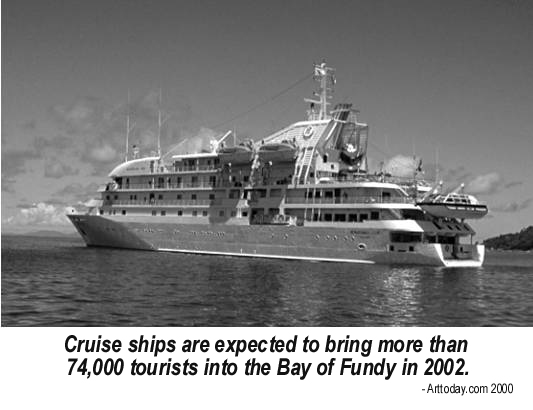
Other, very much larger, tourist-laden vessels are also now plying the
waters of the outer Bay of Fundy in growing numbers. These are the gleaming white,
streamlined, floating hotels with such exotic names as "Regal Empress",
"Brilliance of the Seas" and "Carnival Triumph". Between June and
October of 2002 there will be over 40 visits by such ships to the port of Saint John,
their principal destination in the Bay. Each will carry 500 to 3,000 passengers — a
total of over 74,000 visitors during the season — all eager to enjoy the sights and
attractions of the region. It might be argued that such cruising is hardly ecotourism.
However, unspoiled and scenic coastal waters and abundant marine wildlife are undoubtedly
drawing cards for many passengers. In addition, once ashore in Saint John, many of them
fan out on guided bus tours to picturesque coastal areas such as Grand Manan, St. Andrews,
Campobello Island, Fundy National Park and Hopewell Rocks. Others visit wildlife
sanctuaries and nature parks or set sail for a day of whale and seabird watching. It seems
unlikely that Fundy will ever become as popular a cruising destination as the coastal
areas of British Columbia and Alaska, where more than 25 mega vessels make hundreds of
trips up and down the glaciated, mountainous coast every summer. Nevertheless, over the
past decade, cruise ship traffic in the Bay has increased steadily and shows little sign
of abating, as tourists seek such new, relatively unspoiled places to visit.
The economic benefits of this cruise tourism are substantial; it is estimated that in the past dozen years such visitors contributed over $29 million to the local economy. Less obvious, and more worrisome, are some of the possible environmental effects of these large vessels. Each carries a complement of passengers and crew comparable to the populations of many medium-sized Fundy coastal towns, and generates an equivalent amount of wastes. These include airborne pollutants from the huge oil-fired engines, as well as waterborne wastes discharged untreated into the sea such as raw sewage, oily bilge water, garbage and toxic chemicals from onboard services such as dry-cleaning or photo processing. A recent study of cruise ships in Alaskan waters revealed that 95% of them weren’t complying with federal dumping regulations. The state has now introduced tougher legislation to control pollution from cruise ships, funding the needed monitoring and enforcement by a surcharge on each passenger. There is little comparable information about cruise ship pollution in Fundy waters because there hasn't been any routine monitoring of discharges and inspections of waste treatment systems. Some larger cruise lines are voluntarily improving their procedures for handling wastes and thus reducing the environmental impacts. It is possible too that the added shipping could increase the danger to whales in Fundy, since vessel strikes are one of the major causes of death for whales, particularly endangered North Atlantic right whales. A number of whales in waters off the West Coast were struck and killed by cruise ships in the last few years. Newly developed plans to move shipping lanes in the Bay of Fundy away from areas frequented by whales and a new system of alerting vessels to the presence of whales should minimize such disastrous encounters. Unless the number of cruise ships visiting the region increases dramatically, it is unlikely that they will pose a major threat to the whales or significantly add to pollution in the coastal waters.
Eroding Ecotourism?
In addition to the harm that a too rapidly expanding ecotourism sector may
unwittingly inflict upon itself, there are some other human activities that may make a
place much less attractive to tourists seeking unspoiled natural areas. One of the most
rapidly growing threats to hiking trails, sensitive habitats and natural tranquility are
off-road motorcycles and all terrain vehicles (ATVs). These heavy machines with
deep-treaded tires can render a vulnerable trail almost useless to any other users after
only a few passes. Popular hiking trails on Brier Island, Cape Split and many other places have
already been heavily rutted and eroded by thoughtless ATV riders. Unfortunately, their
destructive effects are not limited to trails. Some users of these high-powered machines
have indiscriminately torn up lakeshore vegetation, churned up beaches and sand dunes,
gouged deep scars across vulnerable wetlands and salt marshes and destroyed fragile flora
and habitats on coastal rocky barrens. Riders have also been known to harass and disturb
wildlife, sometimes inadvertently, but all too often, intentionally. Farmers too are
growing concerned about illegal incursions of these machines onto farmlands where they
damage crops, degrade landscapes and disturb livestock. There is little effective
regulation of ATV use in either province, and governments have done little to curb their
growing environmental impact. Regional ATV organizations, trail associations,
environmental groups and government departments need to work constructively together to
resolve the escalating conflicts. They must ensure that riders have access to and use only
properly designed, well maintained trail systems that are carefully routed to minimize
environmental impacts.
other places have
already been heavily rutted and eroded by thoughtless ATV riders. Unfortunately, their
destructive effects are not limited to trails. Some users of these high-powered machines
have indiscriminately torn up lakeshore vegetation, churned up beaches and sand dunes,
gouged deep scars across vulnerable wetlands and salt marshes and destroyed fragile flora
and habitats on coastal rocky barrens. Riders have also been known to harass and disturb
wildlife, sometimes inadvertently, but all too often, intentionally. Farmers too are
growing concerned about illegal incursions of these machines onto farmlands where they
damage crops, degrade landscapes and disturb livestock. There is little effective
regulation of ATV use in either province, and governments have done little to curb their
growing environmental impact. Regional ATV organizations, trail associations,
environmental groups and government departments need to work constructively together to
resolve the escalating conflicts. They must ensure that riders have access to and use only
properly designed, well maintained trail systems that are carefully routed to minimize
environmental impacts.
There are many other activities that may also undermine a region's ability to attract ecotourists. For example, in Nova Scotia and New Brunswick forestry practices are poorly regulated and widely considered unsustainable. Huge swaths of public and private woodlands are devastated annually by highly mechanized clear cutting throughout the region. Mature, ecologically healthy and biologically diverse natural forests are a rarity in the Maritimes. Any extended wilderness journey on foot or by canoe is sure to be marred by encounters with the unsightly aftermath of commercial deforestation. Hunting also threatens the peace of mind of wilderness travelers seeking an enjoyable outdoor experience for its own sake. Most woodlands are virtually off-limits to safety conscious naturalists and hikers during the fall hunting season. Recurring proposals for a spring bear hunt, and the introduction of wild turkeys for a spring hunt, threaten to close the woodlands to other legitimate users for even longer periods.
The beauty of some coastal areas around the Bay of Fundy, particularly in southwestern New Brunswick, have been marred by the introduction of salmon aquaculture operations in many sheltered embayments. Encountering these massed fish pens detracts from the wilderness experience associated with sea kayaking. A mining industry proposal to extract titanium from the sediments of the lower Shubenacadie River is now being assessed by government regulators. A large floating dredge would suck up large volumes of the river sediment, extract the valuable titanium and release the residue back into the water. The proponent’s claim that this will have negligible ecological effects has yet to be properly evaluated. There are also uncertainties about the effects of such large-scale dredging on the popular tidal bore rafting operations on this river. At the very least, it would deflate the wilderness experience aspect of the excursion.
Many visitors to the Maritimes are impressed by the relatively unrestricted access to
coastal areas, particularly in some of the more scenic, out-of-the-way spots. However, in
some areas, such as the Parrsboro shore, developers or wealthy individuals are acquiring
large tracts of the most desirable coastal land for the construction of seasonal or
year-round residences. This is steadily diminishing traditional access to the coast for
residents and tourists alike. While this is not yet a pressing problem in most of the
Fundy region, governments need to carefully monitor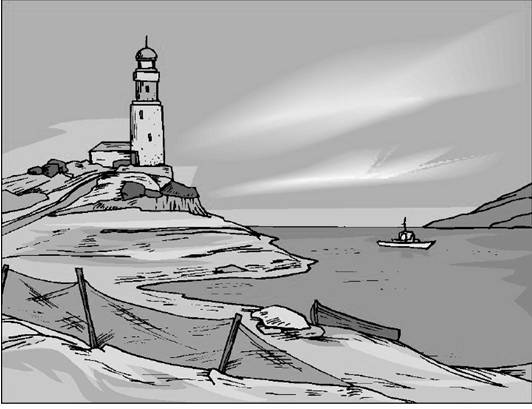 the
situation and take steps to ensure that there will continue to be ample public access to
our most scenic coastal regions.
the
situation and take steps to ensure that there will continue to be ample public access to
our most scenic coastal regions.
Phenomenal Fundy
Ecotourism has a seemingly prosperous future in the Bay of Fundy, if its
expansion is carefully planned and efforts are made to avoid or reduce any harm to the
environment and wildlife. An ongoing dialogue and continuing cooperation among all parties
involved is needed to reduce the impacts of some of the other activities that are largely
incompatible with ecotourism. Some tourism interests and others are suggesting that a
United Nations Environmental, Scientific and Educational Organization (UNESCO) designated
Biosphere Reserve in the upper Bay of Fundy region would attract many more ecotourists to
the area. Proponents of the plan also argue that such a locally-managed initiative, aimed
at fostering environmentally sustainable communities, might encourage different interest
groups to work creatively together to resolve conflicts associated with development and
land use. Together, we can sustain, promote and share with our neighbours and the world
what New Brunswick's Tourism Department proudly bills as:
"the Phenomenal Fundy Coast" and "One of the Marine Wonders of the World".
Further Information
Ecotourism: An Introduction
. David A. Fennell. Routledge, London. 224 pages. (2000).Ecotourism and Sustainable Development: Who Owns Paradise? Martha Honey. Island Press, Washington, DC. 350 pages. (1999).
Grand Manan Whale and Seabird Research Station - whales and whale watching information.www.personal.nbnet.nb.ca/gmwhale/watching.htm
United Nations Environmental Program, "About Ecotourism". www.unepie.org/pc/tourism/ecotourism/home.htm
The International Ecotourism Society (TIES): Ecotourism Explorer. www.ecotourism.org
Fundy Geological Museum. www.museum.gov.ns.ca/fgm/index.html
Surge Inc. , Whale Watch Research Tours. St. Andrews, NB. www.whale-watch.bigstep.com/
Earthwatch Institute - Information about scientific tourism programs worldwide.www.earthwatch.org
This fact sheet may be reproduced and circulated, with credit to the
Bay of Fundy Ecosystem Partnership
The Environmental Conservation Branch
Environment Canada - Atlantic Region
Dartmouth, Nova Scotia
and
Department of Fisheries and Oceans
Scotia-Fundy Region
The views expressed herein are not necessarily those of the supporting agencies.
Written and produced by
J.A. Percy,
Sea Pen Communications
Granville Ferry. N.S.
e-mail: bofep@auracom.com